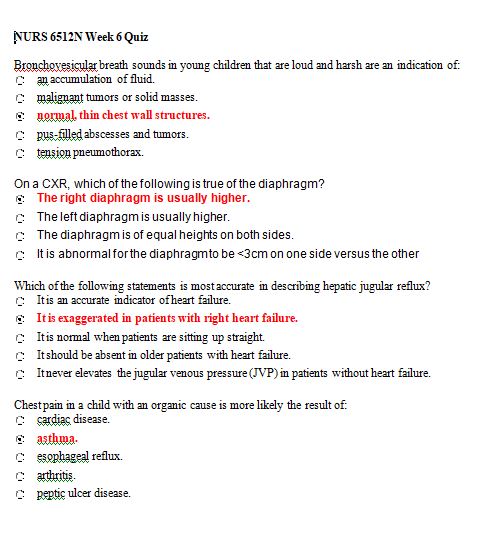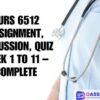Description
NURS 6512N Week 6 Quiz – Question with Answers
- Bronchovesicular breath sounds in young children that are loud and harsh are an indication of:
- On a CXR, which of the following is true of the diaphragm?
- Which of the following statements is most accurate in describing hepatic jugular reflux?
- Chest pain in a child with an organic cause is more likely the result of:
- The American Thoracic Society suggests replacing the term rales with:
- Heart position can vary depending on body habitus. In a short, stocky individual, you would expect the heart to be located:
- Which of following is considered an expected finding in newborns and when found in adults is a concern?
- To assess a patient s jugular veins, he or she should first be placed in which position?
- If pitting edema is unilateral, you would suspect occlusion of a:
- The patient that you are examining is complaining of pain near the spine. While palpating the spinous process at T7, and medially to the inferior border of the right scapula, the patient feels more intense pain. When viewing the chest radiograph, you will carefully look at which rib?
- In newborn infants, closure of the ductus arteriosus usually occurs:
- In the adult, the apical impulse should be most visible when the patient is in what position?
- Persons of Irish or German descent and genetically predisposed women who take birth control pills are at risk for developing:
- An idiopathic spasm of arterioles in the digits is called:
- In differentiating between an occluded artery or vein, a differentiating sign (present in venous but not arterial occlusion) is:
- Electrical activity recorded by the electrocardiogram (ECG) tracing that denotes the spread of the stimulus through the atria is the:
- In children, coarctation of the aorta should be …..if you detect:
- A sound similar to a murmur that is ….over arteries is a:
- Mr. O., age 50, comes for his yearly health assessment, which is ….by his employer. During your initial history-taking interview, Mr. O. mentions that he routinely engages in light exercise. At this time, you should:
- You are conducting an examination of Mr. C. s heart and blood vessels and auscultate a grade III murmur. The intensity of this murmur is:
NURS 6512N Week 6 Quiz 1 – Question and Answers
- On a CXR, which of the following is true of the diaphragm?
- Which of the following statements is most accurate in describing hepatic jugular reflux?
- Chest pain in a child with an organic cause is more likely the result of:
- The American Thoracic Society suggests replacing the term rales with:
- Heart position can vary depending on body habitus. In a short, stocky individual, you would expect the heart to be located:
- Which of following is ….an expected finding in newborns and when found in adults is a concern?
- To assess a patient s jugular veins, he or she should first be ….in which position?
- If pitting edema is unilateral, you would suspect occlusion of a:
- The patient that you are examining is complaining of pain near the spine. While palpating the spinous process at T7, and medially to the inferior border of the right scapula, the patient feels more intense pain. When viewing the chest radiograph, you will carefully look at which rib?
- In newborn infants, closure of the ductus arteriosus usually occurs:
- In the adult, the apical impulse should be most visible when the patient is in what position?
- Persons of Irish or German descent and genetically predisposed women who take birth control pills are at risk for developing:
- An idiopathic spasm of arterioles in the digits is …..
- In differentiating between an ….artery or vein, a differentiating sign (present in venous but not arterial occlusion) is:
- Electrical activity recorded by the electrocardiogram (ECG) tracing that denotes the spread of the stimulus through the atria is the:
- In children, coarctation of the aorta should be suspect if you detect:
- A sound similar to a murmur that is ….over arteries is a:
- Mr. O., age 50, comes for his yearly health assessment, which is ….by his employer. During your initial history-taking interview, Mr. O. mentions that he routinely engages in light exercise. At this time, you should:
- You are conducting an examination of Mr. C. s heart and blood vessels and auscultate a grade III murmur. The intensity of this murmur is:
- Bronchovesicular breath sounds in young children that are loud and harsh are an indication of:









